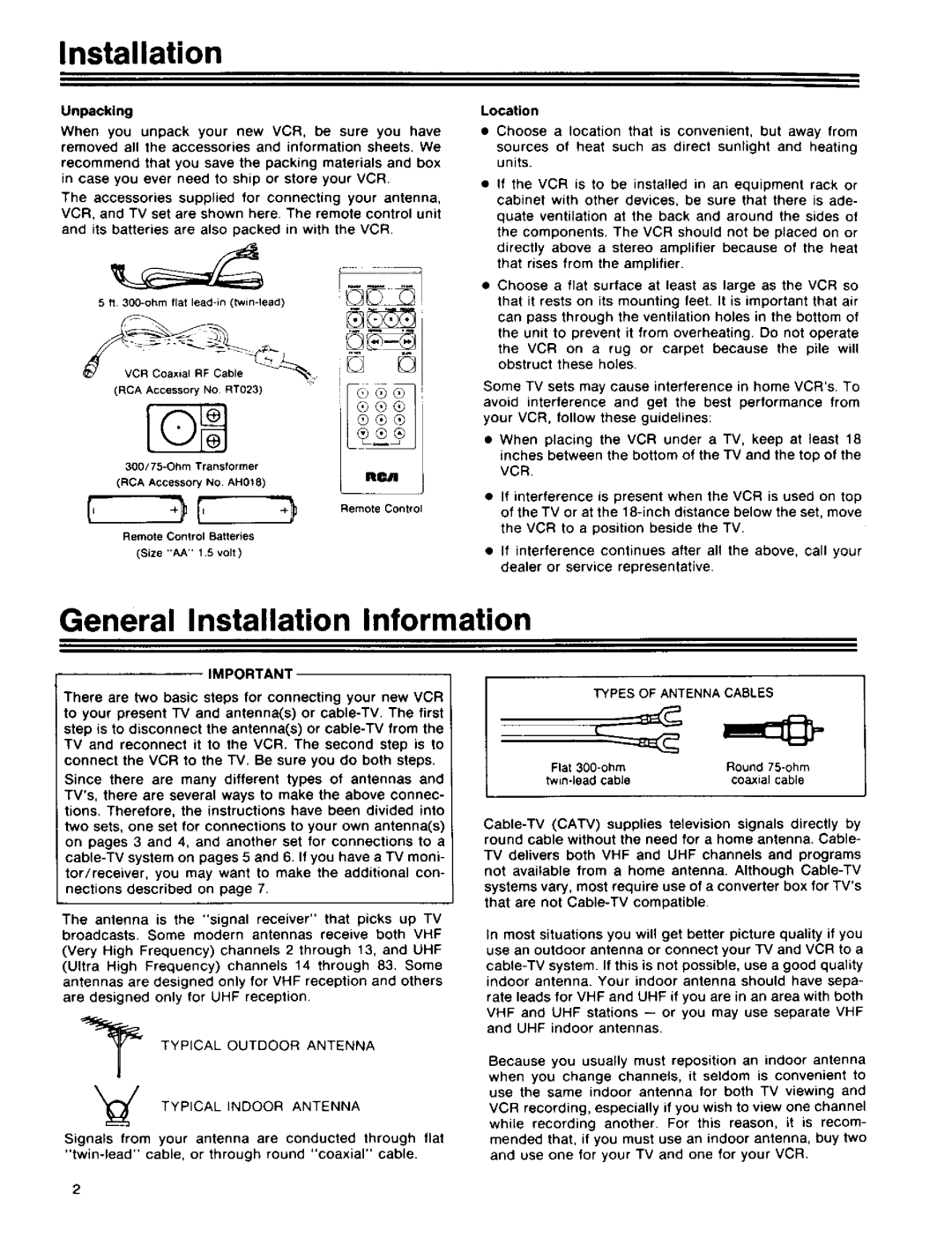
Installation
Unpacking
When you unpack your new VCR, be sure you have removed all the accessories and information sheets. We
recommend that you save the packing materials and box in case you ever need to ship or store your VCR
The accessories supplied for connecting your antenna, VCR, and TV set are shown here. The remote control unit and its batteries are also packed in with the VCR.
5 ft
| 0R |
| Q |
(RCA Accessory No RT023) | _) @® , |
| ®Q® |
| G®® |
Location
•Choose a location that is convenient, but away from sources of heat such as direct sunlight and heating units.
•If the VCR is to be installed in an equipment rack or cabinet with other devices, be sure that there is ade-
quate ventilation at the back and around the sides of the components. The VCR should not be placed on or directly above a stereo amplifier because of the heat that rises from the amplifier.
•Choose a flat surface at least as large as the VCR so that it rests on its mounting feet. It is important that air can pass through the ventilation holes in the bottom of the unit to prevent it from overheating. Do not operate the VCR on a rug or carpet because the pile will obstruct these holes.
Some TV sets may cause interference in home VCR's, To
avoid interference and get the best performance from your VCR, follow these guidelines:
(RCA Accessory NO. AH018)
RM
• | When placing | the VCR | under | a TV, keep at least 18 |
| inches between the bottom of the TV and the top of the | |||
| VCR. |
|
|
|
• | If interference | is present | when | the VCR is used on top |
Remote Control
Remote Control Batteries
(Size "AA" 1.5 volt)
of the | TV or at the | |
the VCR to a position beside the TV. | ||
• If interference continues after all the above, call your | ||
dealer | or service | representative. |
General Installation Information
IMPORTANT
There are two basic steps for connecting your new VCR to your present TV and antenna(s) or
Since there are many different types of antennas and TV's, there are several ways to make the above connec- tions. Therefore, the instructions have been divided into two sets, one set for connections to your own antenna(s) on pages 3 and 4, and another set for connections to a
The antenna is the "signal receiver" that picks up TV broadcasts. Some modern antennas receive both VHF
(Very High Frequency) channels 2 through 13, and UHF (Ultra High Frequency) channels 14 through 83. Some antennas are designed only for VHF reception and others are designed only for UHF reception.
TYPICAL OUTDOOR ANTENNA
_TYPICALINDOOR ANTENNA
Signalsfrom your antenna are conducted through flat
TYPES OF ANTENNA CABLES
Flat | Round |
coaxial cable |
TV delivers both VHF and UHF channels and programs not available from a home antenna. Although
systems vary, most require use of a converter box for TV's that are not
In most situations you will get better picture quality if you use an outdoor antenna or connect your TV and VCR to a
Because you usually must reposition an indoor antenna when you change channels, it seldom is convenient to use the same indoor antenna for both TV viewing and VCR recording, especially if you wish to view one channel while recording another. For this reason, it is recom- mended that, if you must use an indoor antenna, buy two and use one for your TV and one for your VCR.
